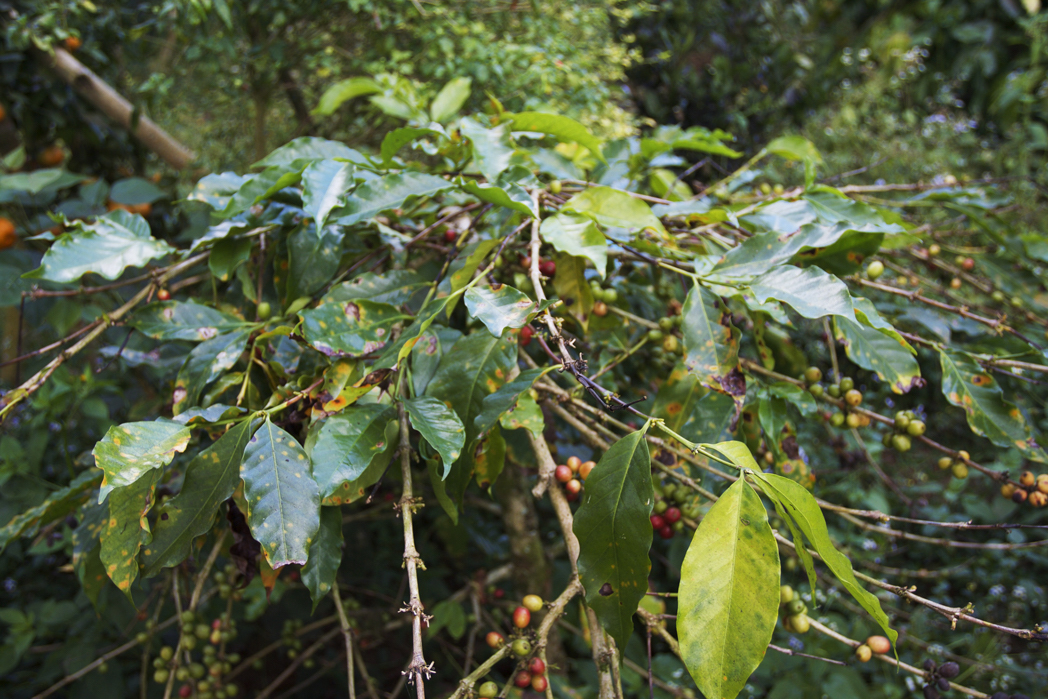
Coffee leaf rust causes brown spots on coffee leaves and typically reduces or eliminates coffee cherry yield. The image “coffee leaf rust defoliation” by Michael C. Wright is licensed under CC BY-SA 4.0.
Colombian coffee leaders are urging growers to turn to disease-resistant coffee varieties upon the discovery of new, more aggressive variants of the coffee leaf rust (CLR) fungus.
The troubling findings come from Cenicafé, the Colombian national coffee research institution of the Colombian Coffee Growers Federation (FNC). The group says it has identified six new races (a.k.a. subspecies) of leaf rust in the country, plus nine new variants of the destructive fungus.
The FNC estimates that approximately 84% of the planted coffee area in Colombia already comprises disease-resistant coffee varieties, although the group is reminding growers that resistance is not the same as immunity.
“The Hemileia vastatrix fungus that causes rust, like any other living microorganism in adverse and diverse environments, can change and mutate in both susceptible and resistant varieties of coffee, its only host,” Carlos Ariel Ángel, researcher at Cenicafé’s Phytopathology Discipline, said in an announcement by the FNC yesterday. “This selection and reaction pressure is a normal dynamic biological process of the fungus, trying to adapt to survive. Hence, just over 50 races have been identified in the world and variants continue to be identified in different countries.”
Related Reading
- Ammunition Needed in the Ongoing Battle with Leaf Rust
- Coffee Leaf Rust Spreads to the Big Island of Hawaii
- The Lasting Impact of Coffee Leaf Rust: Past, Present and Future in the Fight Against Fungus
Given the prevalence of new races and variants, the FNC is encouraging growers to plant anew or replant with proven disease-resistant varieties, such Castillo, Cenicafé 1, Castillo zonales or Tabi — all of which, not coincidentally, have been developed and disseminated at different times by the FNC and Cenicafé.
The group is characterizing disease-resistant variety selection as a front-line defense for preventing the further spread of leaf rust — ahead of the application of fungicides — which has taken a devastating toll on crops throughout Colombia and virtually all of Latin America since the 2012 leaf rust pandemic began.
If left unabated, the disease wipes out approximately 30% to 80% of coffee crops, according to FNC estimates.
Coffee leaf rust has been discovered in most coffee-producing countries for at least 150 years. Despite great strides in research and variety adaptation made over the past decade, the fungus continues to rear its ugly head, providing a direct threat to farmer livelihoods and arabica coffee supplies.
Leaf rust was recently discovered for the first time in Hawaii.
Nick Brown
Nick Brown is the editor of Daily Coffee News by Roast Magazine.






Interesting … I’d missed that … 6 new races and 9 new variants. It’s surely time to reassess the validity of the concept ‘race’ for CLR.
The current dogma is that CLR reproduces asexually, therefore new races evolve fairly slowly by occasional mutation. Unfortunately, unlike Covid-19, no one has been able to detect new variants by molecular changes to genes. Recent work though suggests that CLR can reproduce sexually, which means that the race concept is basically invalid.
I covered this topic in a piece for C&CI where I wrote:
Silva et al. ((2018) Mol. Plant Pathol. 19: 1742-1753 doi: 10.1111/mpp.12657) look at this problem in a comprehensive study of CLR strains from around the world and from different coffee species. They examined 29 isolates of 18 unique CLR races collected from 11 geographical locations and from different coffee species and with this material they analysed about 19,000 SNPs (i.e. single sites along the DNA chain) to look for differences to classify these isolates.
Their analysis revealed three distinct groupings (C1, C2, C3), with eight isolates in C1 and C2 groups coming uniquely from diploid coffee species (C. canephora (Robusta), C. racemosa, C. liberica and C. excelsa), whereas the remaining 21 isolates in C3 were from Arabica and inter-specific tetraploid hybrids. So distinct are these three groups that the authors query whether they might be considered as separate species.
Crucially, no other clear groupings were detected in relation to either geographical location or race. I.e. although races had been previously distinguished by testing them on a range of resistant and susceptible coffee varieties, they could not differentiate these races by molecular means. Evidence was also found of recombination occurring within the C3 Arabica group, which should not be possible if reproduction is asexual.
Hence they question the long-standing assumption that CLR is an asexual pathogen and this has major implications for breeding.
It is surely time therefore for someone to carefully and clearly present the various issues to the wider coffee community, to address such questions as:
How does CLR reproduce? Is CLR more than one species? Should we reorganize coffee species collections to reduce new virulent forms arising? Should ‘classical’ breeding programmes be curtailed to focus on the faster F1 clone approach?